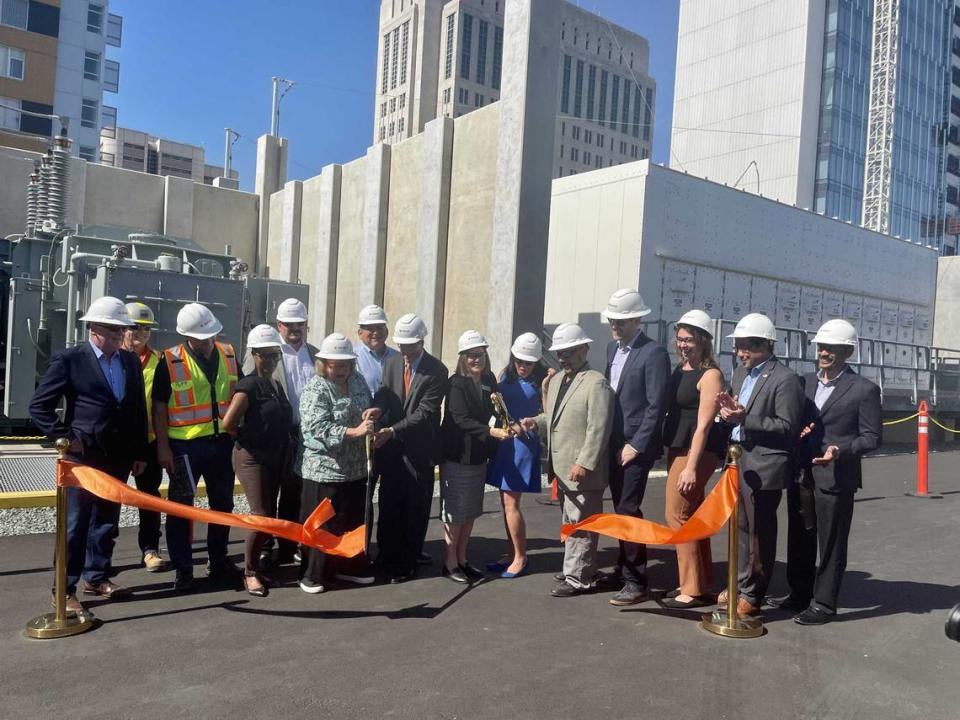New SMUD facility provides power to downtown Sacramento, prepares for city electrification
A new building has been added to the Sacramento city skyline, and in addition to lighting up its high-tech LED facade purple to celebrate Sacramento Kings victories or green and red to celebrate the holidays, it’ll also be lighting up the downtown area with reliable electricity.
Station G, SMUD’s newest functioning substation, was the center of attention at a ribbon-cutting ceremony Thursday morning on the corner of Seventh and G streets, meant to celebrate the completion of the Sacramento Municipal Utility District’s power facility. Organizers said the new substation will distribute energy to the city’s expanding core for decades to come.
SMUD owns and operates several substations throughout Sacramento and Placer counties. These facilities take in high-voltage electricity and step it down to lower voltages so that it can be safely supplied to homes and businesses at the appropriate power level.
Construction on Station G began in August 2020, and was completed slightly ahead of its projected completion of summer 2023. It took over for Station A, a street over on H Street, with the station’s 18 circuits transferred one-by-one over the course of two months last fall.
The station was largely designed to meet the energy needs of a growing downtown population, according to SMUD chief operating officer Frankie McDermott, especially as the city and the state lean into electrification of cars and buildings.
But the builders and designers also had some other goals in mind when updating the traditional substation design: increased safety and reliability, and better aesthetics.
“The substation’s design blends well, I think, into this vibrant downtown landscape,” said SMUD board president Heidi Sanborn. “(We want) to ensure Station G is adding to the city’s aesthetic appeal.”
Sanborn said the design of the building, to this goal, includes programmable lights that can change colors for any occasion, as well as a protective perimeter with decorative panels that “emulate the Sacramento River.”
“We lit it up as Kings purple during the playoffs,” Sanborn said. “It’s another way to bring up the community spirit in the area.”
A bright future for Sacramento — with fewer power outages
The station was built with contingencies in mind, according to electrical engineer Joe Dray: from water-protected systems, to blast walls around the station’s transformers, SMUD is hoping to avoid power outages for customers — and especially long ones — as much as possible.
This is especially true for high-profile downtown buildings that SMUD’s system serves, such as the state Capitol building and the Sacramento County Main Jail.
One of the ways the design of Station G ensures reliability, Dray said, is through a system of redundancies: if one circuit is damaged or out of commission, a secondary unit can “pick up the slack.”
Station G was also designed with remote operation capabilities: on a regular day, no one is at the site — but if something goes wrong, SMUD crews can diagnose problems and even remotely repair certain fixes without needing to step foot on the site.
Dray said that this system should guarantee that power outages downtown are “very rare.”
The most notable downtown power blackout in recent years came in December 2021 when a fire at Station A left some customers without power for up to 67 hours. The fire, which investigations showed may have been caused by water seeping into equipment, took place days after a historical atmospheric river flooded Sacramento roadways and knocked down trees throughout the region.
SMUD has owned Station A since the 1940s and built an outdoor portion in the 1950s. But while a 2015 report from SMUD acknowledged that the existing equipment was “nearing the end of useful life,” consultants investigating the cause of the blackout said that, according to SMUD records, “the incident equipment had been regularly tested and maintained,” and the age of the facility wasn’t necessarily the cause of the fire.
Still, Nicole Cuellar, a policy advisor to Mayor Darrell Steinberg, said that the Station G failsafes will be “a critical piece of our grid resiliency.” She and Sacramento County Supervisor Phil Serna both referenced the increasing importance of reliable electricity in line with the state of California’s ambitious electrification goals.
“It’s going to be power stations like this that are critically important to the totality of infrastructure that’s necessary for the green economy that we all strive for,” Serna said.

What’s going to happen to Station A?
The equipment in Station A is removed, and the outdoor portion of the substation is being demolished or dismantled, a process that SMUD program manager and engineer Amandeep Singh said began earlier this year.
The utility plans to build a new substation, Station H, on the property, to help provide power to Sacramento’s Railyard neighborhood. McDermott said Station H is loosely expected to be operational in 2025.
McDermott said that while there are some ideas, a final plan for the brick building that housed Station A, which was built in 1894 and is considered a California Historical Landmark, hasn’t been determined at this time.

